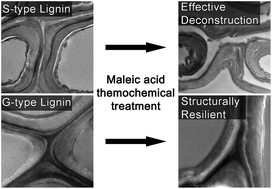Engineering plant cell walls: tuning lignin monomer composition for deconstructable biofuel feedstocks or resilient biomaterials†
Abstract
Advances in genetic manipulation of the biopolymers that compose plant cell walls will facilitate more efficient production of biofuels and chemicals from biomass and lead to specialized biomaterials with tailored properties. Here we investigate several genetic variants of Arabidopsis: the wild type, which makes a lignin polymer of primarily guaiacyl (G) and syringyl (S) monomeric units, the fah1 mutant, which makes lignin from almost exclusively G subunits, and a ferulate 5-hydroxylase (F5H) overexpressing line (C4H:F5H) that makes lignin from S subunits. We employ multiscale, multimodal imaging techniques that reveal the biomass of the C4H:F5H transgenic to be more susceptible to deconstruction by maleic acid treatment than the other variants. Enzymatic saccharification assays of the treated materials show that C4H:F5H transgenic tissue is significantly more digestible than the wild type, while the fah1 mutant is clearly the least digestible of these materials. Finally, we show by contact resonance force microscopy, an atomic force microscopy technique, that F5H overexpression in C4H:F5H transgenic plants significantly reduces the stiffness of the cell walls in the region of the compound middle lamella relative to wild type and fah1.


 Please wait while we load your content...
Please wait while we load your content...